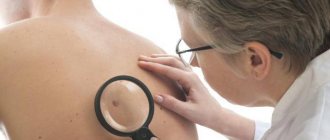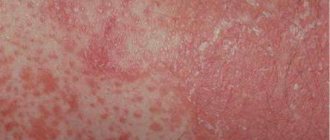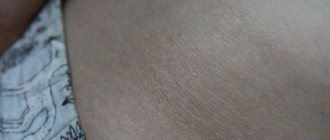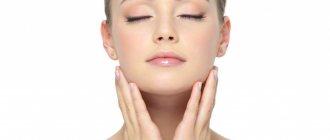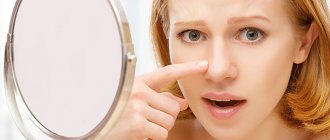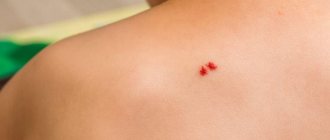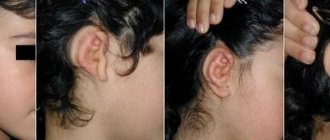from February 4, 2021
Keratosis or hyperkeratosis is a non-inflammatory form of dermatosis, which is accompanied by excessive keratinization of the skin.
For healthy skin of any person, the process of keratinization is a normal physiological state. The process of keratinization provides one of the most basic functions of the skin - protective.
MECHANISM OF KERAINIZATION IN NORMAL AND IN HYPERKERATOSIS
Normally, as a result of their vital activity, skin cells gradually move from the lower layer to the upper, while gradually accumulating keratin - a protein that makes them more durable and resistant to external influences. The top layer of skin is nothing more than completely keratinized cells or horny scales, which are peeled off and replaced with new ones during human life. Such cells lack viability, but at the same time, thanks to keratin, they provide protection to living cells located underneath them from negative environmental factors.
With the development of hyperkeratosis as a pathological condition of the skin
- on the one hand, there is an active accelerated division of epidermal cells that produce keratin;
- on the other hand, there is a delay in the process of normal physiological exfoliation of horny scales from the surface layer of the skin.
Methods of treating the disease of the chosen ones
Is there a method today that guarantees a 100% recovery? We asked Tatyana Sukhova, a dermatologist,
highest category of Moscow clinic.
Cuban doctors have achieved the best results in treating the disease. The method involves administering intramuscular injections of vitamins into depigmented areas. But even he cannot cope with the disease completely. Vitiligo treatment at the Dead Sea is now being actively advertised. Israeli doctors were able to obtain pigment on a white spot, but this, alas, does not always look beautiful and, again, does not guarantee complete healing. In our country, the most effective method in the treatment of vitiligo is considered to be a combination of UV and PUVA therapy with the use of photosensitizing drugs. As a result, it is possible to “revive” the white spots, but, unfortunately, it will not be possible to get rid of them completely.
Folk remedies for spots
Among practicing doctors there is also the following opinion: vitiligo is not a disease, but only a cosmetic skin defect. This means that you need to treat it as normal pigmentation, using herbal medicine, as well as masking the spots with regular foundation. If you choose a shade similar in color to a healthy area of skin, then no one will notice vitiligo. Only on condition that this product is approved by a doctor, since many foundations contain microsubstances that affect pigmentation and can enhance the development of the disease.
TYPES OF KERATOSIS
Most often, the phenomena of hyperkeratosis are localized on the legs (heels, feet, knees) and arms (palms, elbows), less often - on the scalp, face in the area of the nose, cheeks, forehead. Basically, this pathology is formed in areas of irritation by any external mechanical or environmental factors. However, hormonal imbalances, heredity and improper skin care can also provoke hyperkeratosis.
The most common types of manifestations of hyperkeratosis are:
- Actinic (solar) keratosis on the face and body (keratomas). It develops due to excessive exposure of the skin to ultraviolet rays and photodamage. Appears as flat, rough yellow or brown spots;
- Palmar and plantar keratoderma - calluses, corns on the soles of the feet and palms, heel cracks. Formed in areas exposed to prolonged friction or pressure, during infectious and fungal diseases;
- Follicular or pilaris keratosis (“goose bumps”). Dermatosis occurs as a result of both accelerated keratinization and disruption of the physiological desquamation of horny scales. Against this background, the normal secretion of sebum is disrupted and local inflammation of the hair follicles on the body occurs. It looks like a rash of small multiple nodules of bright pink and gray color on the face, shoulders, legs, buttocks;
- Seborrheic keratosis is the most common form of hyperkeratosis. It is a hyperpigmented “plaque” with clear boundaries from light to dark brown, covered with keratinized skin. It can be either single or multiple.
- Actinic keratosis - develops in old age in the form of beige-brown spots and is localized on the face, shoulders, back, and back of the hands.
Distinctive signs of vitiligo
The affected areas and healthy epidermis are clearly demarcated.
A characteristic symptom of the disease is the absence of scales in areas of spotting. The lesions themselves do not have elements protruding above the surface of the skin. Upon closer examination, you will notice that the pigment shifts to the edges of the spots, and the skin in these places has a more intense color. The hairs growing on areas of vitiligo are also discolored, like the skin. The patient has no pain or itching or other unpleasant sensations. Recently, it has been found that skin covered with vitiligo patches is highly sensitive to ultraviolet rays. After irradiation, the skin in the area of pathology does not become tanned, and the surrounding hyperpigmented areas become even darker.
The sweat glands contained in the affected skin do not function fully. This provokes disturbances in the sweating process.
REASONS FOR THE DEVELOPMENT OF KERATOSIS
Factors causing the development of hyperkeratosis are divided into external and internal.
External factors that provoke hyperkeratosis include chronic inflammatory processes on the skin, infections, ultraviolet radiation, exposure to aggressive chemicals, as well as strong pressure, for example, tight shoes, a tight hat, hairpins, headbands, improper skin care and incorrectly selected cosmetics, which causes dry skin, as well as a lack of vitamins A, C, D, etc.
If the pathology has formed without prior irritation or injury, then skin hyperkeratosis is probably caused by internal factors. In this case, it may be hereditary diseases, dry skin due to metabolic disorders, liver disease, gall bladder, thyroid disease, diabetes mellitus, congenital pathologies. In addition, manifestations of hyperkeratosis occur and accompany some chronic skin diseases - eczema, psoriasis, lichen planus, seborrhea, erythroderma, keratoderma.
Diagnosis of hyperemia
Red facial skin can be both a protective reaction to irritants and a signal of disturbances in the human body. Timely diagnosis and treatment help delay the development of serious pathologies. Studying the problem begins with collecting complaints and medical history. Thus, episodes of skin color changes should be carefully analyzed.
If the redness on the face is of a short-term local nature, has a clear connection with any cause, goes away on its own after it is eliminated and is not accompanied by other symptoms, then a person can cope with the change in skin color without outside help.
In cases of systematic red spots on the face, the causes of which are unclear, the help of a specialist is necessary. The reason to urgently contact him is the simultaneous combination of redness on the face and peeling, itching, burning, microcracks, as well as general weakness, fatigue and disruption of the internal organs.
In such cases, laboratory tests of blood and urine, available instrumental studies of the cardiovascular system (measurement of blood pressure and pulse, ECG and assessment of the condition of blood vessels) are performed. Taking into account preliminary data, the doctor may prescribe dermatological and allergological tests, determination of the hormonal profile, and in-depth instrumental procedures (radiography, ultrasound, MRI, CT).
Modern laboratory and instrumental equipment will provide the opportunity for comprehensive general clinical observation, and the joint work of several specialists will make it possible to more accurately determine the nature of facial redness and its causes.
HOW TO TREAT HYPERKERATOSIS
Symptoms of hyperkeratosis usually do not cause pain and are considered a cosmetic defect. The exception is calluses and corns on the feet, which cause discomfort when walking. In this case, you should immediately seek qualified help, especially if the manifestations of hyperkeratosis cause pain, discomfort, there are symptoms of infection (redness, swelling, accumulation of pus) or if you have diabetes.
Hyperkeratosis will not go away on its own; in any case, it is necessary to start treatment.
The method of treating hyperkeratosis is chosen by the doctor, taking into account the cause, location, prevalence and shape of the thickenings, as well as compensation for the underlying chronic disease as a result of which the pathological process was formed.
To treat hyperkeratosis, the following are most often used:
- ointments, creams with a softening effect; creams rich in fat;
- taking acitretin;
- Daivonex ointment (calcipotriol);
- medical hardware manicure (if the process is localized on the palms, feet, arms and legs);
- creams with urea;
- peeling, including chemical and laser peeling (face and body);
- radiosurgical removal (keratomas);
- surgical cutting (calluses, corns).
You cannot remove calluses, corns or warts on your own, as there is a risk of infection and other complications.
Localization and size of spots
The disease is not characterized by a specific localization. Spotting can appear in any places:
- on the head;
- in the eyebrows;
- in the groin area.
It is not typical for vitiligo to be localized in the area of the palms, feet or mucous membranes. Most often, the spots cover the external genitalia, which is why the pathology can be mistaken for signs of sexually transmitted infections. The disease also tends to affect the back of the hands and the skin between the buttocks. Sometimes the signs of vitiligo take on a peculiar form - small white spots alternating with areas of healthy skin.
In rare cases, small spots with increased pigmentation are present inside the lesions. At the very beginning of formation, the foci are small in size. Gradually, the affected area can increase due to the combination of pathological elements, covering a larger surface of the skin. In this way, large spots with irregular outlines are formed. At the same time, the characteristic clinic of the pathology is preserved - increased coloration of the skin along the edges of the spotty formations. In some patients, the spots can become gigantic, covering the entire buttock area, back or abdomen. In isolated cases, the lesion can cover the entire skin of the body.
In many situations, the disease does not occur in isolation, but in combination with various disorders - scleroderma, baldness, Satten's nevus, porphyrin disease. Specific signs of vitiligo, by which it can be distinguished from other pathologies, are the absence of peeling and skin atrophy in any form of the disease.
How to disguise white spots on the skin?
White spots on the skin are well masked by fresh rhubarb root juice, which is used to lubricate the spots in the morning and evening. As a result, the white spots turn tan color.
An alcohol tincture of green leaves and pericarp of walnuts, taken in equal parts, is also effective. If you apply it to stains twice a day, they will darken for a long time.
St. John's wort for vitiligo
You can use an infusion of St. John's wort (1 tbsp herb to 1 tbsp boiling water, leave for half an hour). Take 1 tbsp. l. 3 times a day after meals. After three weeks - a week break. And so on for 4-6 months.
At the same time, it is advisable to lubricate the white spots with St. John's wort oil. To prepare it you need to take 1 tbsp. l. herbs, pour 1/2 tbsp. vegetable oil and keep in a water bath for three hours. Then filter and squeeze. St. John's wort increases the skin's sensitivity to ultraviolet radiation, so after the procedure it is recommended to stay in the sun: on the first day - only 1-2 minutes, adding 1-2 minutes every day. The course of treatment is at least a month.
Red pepper tincture
Apply tincture of red capsicum (can be bought at a pharmacy) to white spots 3 times a day for 5-10 minutes. Be prepared for a strong burning sensation. After rubbing, you can spend a few minutes in the sun. Repeat the procedure daily for 2 weeks.
Anise oil
Grind 100 g of anise fruit in a mortar, pour in 0.5 liters of olive oil and leave for a month in a dark place. After this, bring to a boil (but do not boil!), cool and strain. White spots should be constantly lubricated with this oil. In a month or two they will darken significantly and will not be so noticeable.
